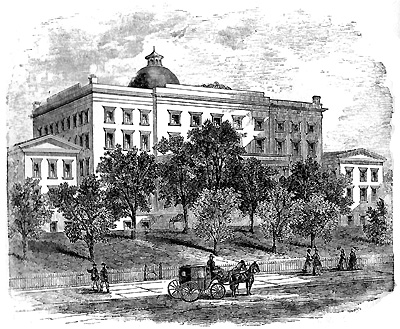|
|
Chapter IV
New York As It Is.
The Schools and Colleges of New York A. Description of the Island.—
B. Population at Different Periods.—
C. Streets and Avenues.—
D. Architecture of Manhattan—
E. Business in New York—
F. Churches of New York—
G. Parks and Squares.—
H. How New York is Supplied with Water.—
I. The Schools and Colleges of New York.—
J. Public Security—
K. New York All the Year Round—
L. The Libraries, Monuments and Markets of New York—
M. The Cemeteries of New York.
The Schools and Colleges of New York, page 2
 Columbia College—Fiftieth Street, between 4th and 5th Avenues. It was not until near the close of the last century that the public mind was aroused to the importance of providing the means for the general education of the people. From the establishment of the English government in 1664, down to 1795, all efforts to educate the masses were made by individuals, or by local churches; but in the year last named, in compliance with the recommendation of that enlightened governor, George Clinton, the New York Legislature passed an act, appropriating $50,000 a year for five years, for the maintenance of schools in the several cities and towns of the State, in which the children should be taught English grammar, arithmetic, mathematics, and such other branches of knowledge as are necessary to complete a good English education. In 1805, the State government set apart the net proceeds from the sale of 500,000 acres of vacant lands, for a permanent fund, for the support of common schools, to be securely invested until the interest thereof should amount to $50,000 per annum, which sum was to be annually divided between the several school districts, according to the number of their scholars. This fund was further increased by the proceeds of certain bank stocks and of the lotteries authorized by the Act of 1803. The first distribution occurred in 1815. A little previous to this movement in the Legislature, organizations began to spring up, both in Europe and America, for the education of the poor and the neglected. The "Manumission Society," to improve the condition of the colored race, organized in 1785, was the first in our country, and two years later it established a school in Cliff street, and soon gathered one hundred pupils. This society continued its work for forty years, firmly established several schools, but in 1834, voluntarily surrendered its charge with considerable valuable school property to the State government. These are now the Colored Schools, under control of the Board of Education. A "Female Association for the Relief of the Poor," was organized, and in 1802 opened a school for white girls. This society existed about half a century, proved the feasibility of such undertakings, and led to the organization of the "Free School Society," which afterwards became the "Public School Society of the City of New York." The "Lancaster system," viz.: that five hundred or a thousand children could be properly instructed by a single teacher, then very popular in England, was introduced into this city, and in due time failed. In 1827, a number of ladies organized the "Infant School Society," and the next year the same was introduced into Boston, Charleston, and other places. The movement now looks to us supremely silly. Children were received into these schools in New York at from two to six years of age, and in Boston, always in the advance, at from eighteen months to four years. The system of instruction adopted was the "Pestalozzian," and does not differ materially from the course pursued at present, by most infant-class teachers, in our Sunday schools. |
|
100
:: Previous Page :: Next Page ::
Books & articles appearing here are modified adaptations
from a private collection of vintage books & magazines. Reproduction of these pages is prohibited without written permission. © Laurel O’Donnell, 1996-2006.
|
|
